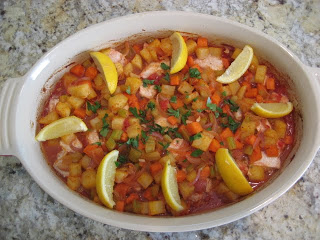 We’re working hard at getting more fish into our diet in place of red meat. But sometimes the closer we look, the more we wonder if we’re really making a healthier choice.
We’re working hard at getting more fish into our diet in place of red meat. But sometimes the closer we look, the more we wonder if we’re really making a healthier choice.
For example, our local supermarket was recently advertising a “buy one, get one” sale on frozen tilapia. We like tilapia — it’s mild, quickly cooked and lends itself nicely to seasoning.
We picked up two packages but quickly put them back when we read this on the label: “Product of China,” and “treated with carbon monoxide.”
Whoa! On both counts.
Chinese seafood has been the repeated target of warnings and even import restrictions because of safety concerns, particularly pollution. Tilapia was never banned and American importers say the Chinese have raised standards in recent years, but we’re skeptics — and we’re never in the mood to experiment with dinner.
Why should we? American farm-raised tilapia is abundant, safe and considered ecologically sustainable.
And no matter its origin, we don’t want our fish — or anything on our plates — treated with carbon monoxide.
We first heard about gassed food products a few years ago, when packagers discovered that a blast of CO gas sealed inside the plastic wrapping kept meat looking red and fresh long after it would have normally turned brown and disgusting.
News reports touched off a consumer revolt that eventually prodded many major grocery chains to abandon the practice, even though the Food and Drug Administration refused to step in.
But even some chains that claim not to sell gas-treated meat are apparently still selling seafood treated the same way. Tuna is reportedly the most commonly gas-blasted fish because the resulting deep-pink tinge is just what consumers expect from “fresh” tuna.
Let me admit here that I’m probably biased by my experience as a newspaper reporter. My pals at the county morgue told me years ago that the bodies of carbon monoxide victims turn pink. It’s not exactly an appetite-enhancing image.
Regardless, the problem with artificially enhanced food color is obvious: It’s one less way of knowing whether what we’re buying is really fresh.
The FDA says it hasn’t stopped the practice because carbon monoxide doesn’t harm the food. When used in this manner, CO falls into the category of substances the agency calls GRAS, meaning “generally regarded as safe.”
Here at TheArmenianKitchen.com, we have our own category for carbon monoxide-treated food: GRAD.
That is, “generally regarded as disgusting.”
We’ll pass on gas-enhanced fish

(Visited 50 times, 1 visits today)

